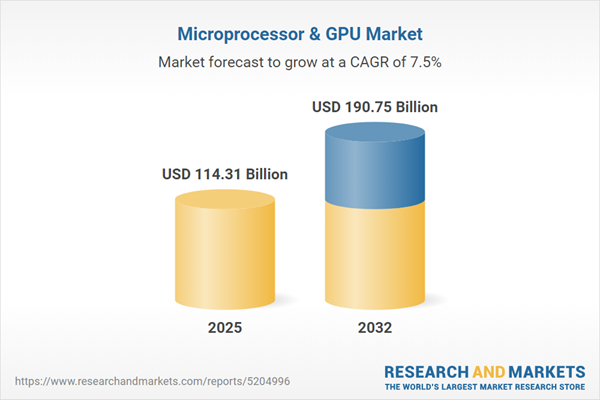Speak directly to the analyst to clarify any post sales queries you may have.
The microprocessor and GPU market is at the forefront of technological change, enabling advanced computing for artificial intelligence, edge deployment, and data-intensive applications. As innovation and competition accelerate, market dynamics demand strategic insight from industry leaders.
Market Snapshot: Microprocessor & GPU Market Growth Outlook
The microprocessor and GPU market grew from USD 106.82 billion in 2024 to USD 114.31 billion in 2025, and is forecast to maintain robust expansion at a CAGR of 7.51%, ultimately reaching USD 190.75 billion by 2032. Rising demand for AI, high-performance computing, and edge applications propels this market, with industry players adapting to evolving regional regulations, supply chain shifts, and changing user expectations.
Scope & Segmentation of the Microprocessor & GPU Market
- Product Types: Discrete GPUs, Integrated GPUs, Array Processors, Digital Signal Processors, RISC & CISC Processors, Scalar Processors, Symbolic Processors, Vector Processors.
- Deployment Types: On-cloud services, In-premise infrastructure.
- End Users: Automotive, Data Centers, Defense & Aerospace, Healthcare (Diagnostics Equipment, Medical Imaging), Industrial Automation, Consumer Electronics (Mobile, PCs & Laptops, Smartphones).
- Sales Channels: Offline, Online.
- Regional Coverage: Americas (United States, Canada, Mexico, Brazil, Argentina, Chile, Colombia, Peru), Europe (United Kingdom, Germany, France, Russia, Italy, Spain, Netherlands, Sweden, Poland, Switzerland), Middle East (United Arab Emirates, Saudi Arabia, Qatar, Turkey, Israel), Africa (South Africa, Nigeria, Egypt, Kenya), Asia-Pacific (China, India, Japan, Australia, South Korea, Indonesia, Thailand, Malaysia, Singapore, Taiwan).
- Key Players Analyzed: Advanced Micro Devices, AFOX Corporation, Apple, ARM Limited, ASUSTeK Computer, Broadcom, Changsha Jingjia Microelectronics, EVGA Corporation, Galaxy Microsystems, GIGA-BYTE Technology, Imagination Technologies, Intel, IBM, MediaTek, Micro-Star International, NVIDIA, PNY Technologies, Qualcomm, Samsung Electronics, Sapphire Technology, Sony Group, TSMC, Texas Instruments, VIA Technologies, ZOTAC International.
Key Takeaways for Senior Decision-Makers
- The convergence of microprocessor and GPU architectures is redefining performance thresholds in AI, machine learning, and real-time data analytics.
- Emergence of heterogeneous computing and advanced packaging is leading to flexible workload allocation and higher efficiency across devices and environments.
- Supply chain resilience and geographic diversification are prioritized as market participants respond to geopolitical events and regulatory change.
- Integration of specialized accelerators and domain-specific cores supports growing demand for edge intelligence and latency-sensitive workloads.
- Strategic collaborations within hardware, software, and foundry ecosystems are accelerating solution deployment and reducing integration risk.
- Open-source and niche vendors continue to influence the landscape, offering differentiated value in sustainable design and customizable platforms.
Tariff Impact on Microprocessor & GPU Supply Chains
Recent United States tariff measures are reshaping global semiconductor logistics. Increased duties have raised input costs and prompted localization of wafer fabrication, assembly, and advanced packaging. Consequently, operational costs have risen temporarily, yet the industry is experiencing renewed investment in regional manufacturing and skills development, promoting long-term adaptability and regional self-reliance.
Research Methodology & Data Sources
The analysis uses robust primary and secondary research, combining executive interviews, academic consultation, and systematic reviews of technical literature. Data triangulation ensures reliability, with expert workshops validating emerging trends and risk scenarios to deliver a complete, unbiased picture.
Why This Report Matters
- Provides an actionable framework for strategic planning and investment decisions in a rapidly transforming sector.
- Equips executives with segment-level intelligence to accurately position products, select suppliers, and configure supply chains.
- Delivers critical insights into trends affecting regulatory landscape, technology adoption, and competitive positioning for market-leading organizations.
Conclusion
The microprocessor and GPU market is undergoing rapid transformation, with architecture convergence, regional realignment, and accelerated innovation setting the stage. Decision-makers equipped with this insight will be best positioned to navigate ongoing change and shape the industry's trajectory.
Additional Product Information:
- Purchase of this report includes 1 year online access with quarterly updates.
- This report can be updated on request. Please contact our Customer Experience team using the Ask a Question widget on our website.
Table of Contents
3. Executive Summary
4. Market Overview
7. Cumulative Impact of Artificial Intelligence 2025
Companies Mentioned
The companies profiled in this Microprocessor & GPU market report include:- Advanced Micro Devices, Inc.
- AFOX Corporation
- Apple Inc.
- ARM Limited
- ASUSTeK Computer Inc
- Broadcom Inc.
- Changsha Jingjia Microelectronics Co., Ltd.
- EVGA Corporation
- Galaxy Microsystems Ltd.
- GIGA-BYTE Technology Co., Ltd
- Imagination Technologies Limited
- Intel Corporation
- International Business Machines Corporation
- MediaTek Inc.
- Micro-Star International Co., Ltd.
- NVIDIA Corporation
- PNY Technologies, Inc.
- Qualcomm Incorporated
- Samsung Electronics Co., Ltd.
- Sapphire Technology Limited
- Sony Group Corporation
- Taiwan Semiconductor Manufacturing Company Limited
- Texas Instruments Incorporated
- VIA Technologies Inc.
- ZOTAC International (MCO) Limited
Table Information
| Report Attribute | Details |
|---|---|
| No. of Pages | 187 |
| Published | November 2025 |
| Forecast Period | 2025 - 2032 |
| Estimated Market Value ( USD | $ 114.31 Billion |
| Forecasted Market Value ( USD | $ 190.75 Billion |
| Compound Annual Growth Rate | 7.5% |
| Regions Covered | Global |
| No. of Companies Mentioned | 26 |









